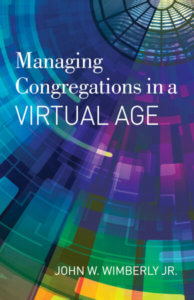Are virtual meetings and work-from-home staff part of the new normal in your church? In this in-depth interview John Wimberly shares best practices for working with staff and volunteers in a hybrid era.
Listen to this interview, watch the interview video, or continue reading.
Ann Michel: You’ve written that the transition to digital worship most congregations made in response to the pandemic was relatively easy compared to the issues of managing staff and volunteers in the virtual sphere. Can you explain why you believe that to be the case?
John Wimberly: Well, any pastor is going to object to the idea that transitioning to digital worship was easy. Nonetheless, compared to managing people, it was easier. I’ve got to hand it to clergy and congregations across the country, small to large, who made that transition so quickly and so well. But that was technology. You bought things. You learned things. And you learned how to apply the technology you had. As a preacher, you had to learn some tricks about communicating with a camera versus communicating with a live audience. But it’s nothing like managing people. Managing people is always going to be the most difficult thing, and frankly the most fun thing, that we do as clergy.
The other factor is that very few seminaries really teach much about managing people. Wesley, Columbia, a few others have done a really good job of educating clergy once they are out in the field. But a lot of seminaries never do, so managing people is something you either learn to do or fail to do pretty much on your own.
In my first book, The Business of the Church, I devote a lot of time to managing people because it’s so important. Your whole ministry can fall apart if you don’t manage staff correctly. As a consultant, I work all the time with congregations where typically the senior minister has made some kind of mistake in managing people. And it’s created all kinds of tension within the life of the congregation. The way I frame the whole issue of managing people in a virtual setting is that most clergy weren’t very good at managing someone who was down the hall in their office, so what happens when they were across town or maybe in another state? It just amps it up.
Ann Michel: Can you name some issues that should be top of mind for churches in this era when many of their staff and volunteers may be opting to connect remotely?
John Wimberly: The number one thing has to do with output productivity. What do we expect from people? And that should have been the issue when the person was down the hall, as well. Because it’s not like the first time they had the opportunity to use the computer for less than work-oriented reasons was when they moved to work from home. They can do that in the office, too.
So how do you deal with that? You create very clear productivity outcomes. “This is what we want you to do.” You don’t tell them how to do it. You hire people who’ve got an entrepreneurial, self-starting approach to reality and to work. And then you let them do it. But you have to be clear about what it is you want. And then the hardest part is holding people accountable for whatever that output standard is. If they said they were going to do X, but they did Y, then there has to be a conversation. And that’s no easy conversation. The church and accountability just have such a bad relationship.
Ann Michel: So, what are some of the ways that congregations can hold their staff accountable, both in person and in virtual spaces?
John Wimberly: Well, the first thing is defining the output. You have to say, this is what we want you to do, and this is the quality of work that we expect. And then there has to be some kind of time frame, so let’s say in three months or six months or a year. The time frame kind of depends on the task. Some things take a year to get done, some things take a week. But you say, “We’re going to evaluate this.”
I’m not a big believer in annual performance reviews. In fact, I don’t believe in them at all. And there’s a lot of research to back this up. There has to be ongoing performance review. Sometimes when I’m working with a church on staff design the senior pastor will say, “We’ve got one person who’s really not very effective. She’s a wonderful person. And the congregation really loves her.” And I’ll say, “How long has the person been working there?” “Thirteen years.” How can you run an organization by tolerating such people? And I don’t think we’re doing any favors to the person who’s been there and under functioning for 13 years, either.
Ann Michel: Beyond this issue of how staff are held accountable, what other issues do church leaders need to think about in this new way of engaging?
John Wimberly: During the pandemic I interviewed a lot of clergy, both rabbis and Christian clergy. And they said that the single most difficult thing for them was the lack of what I would call “hallway conversations.” And one rabbi said their staff were getting irritated with each other because certain things weren’t happening. And they couldn’t quite figure out why. And they realized that they had been coordinating a lot of their work as they walked by each other in hallways, or as they met in the office, or saw each other in the parking lot. So one of the issues about being virtual is that there has to be some very strong intentionality about communicating, on a daily basis probably, so that those kind of tasks don’t get lost.
I’m convinced that a lot of staff stuff is going to become more virtual rather than less virtual. It’s the same thing with meetings. People have figured out they don’t have to drive 20 minutes to church to go to a one-hour meeting and then drive 20 minutes home. I don’t see that happening ever again. They will get together for big meetings like council meetings or church governing board meetings. But a lot of these meetings are going to be virtual. So, managing that and building a communications system in which everybody can stay connected is going to be a challenge.
Ann Michel: In the church I attend, I feel like people who always were “in the know” about everything don’t know what’s going on, for the very reason you described. All these small groups are together virtually. But the connector points, the informal communication that kept everything together, is just kind of missing.
John Wimberly: Yeah, it’s true. The amount of anxiety in the air right now is crazy. Because we’ve lost a sense of what it’s like to be connected that way.
Ann Michel: For those leading digital meetings, what do they need to be doing differently? How is the function of managing a group different?
John Wimberly: I’ve done a lot of reading about things to do and things not to do in virtual meetings in the business world. In a lot of companies, you cannot go off screen. And in church meetings people routinely go off screen. And you say, “Well, what’s the big deal with that? It’s a privacy issue.” Well, the big deal is most of us sit there and think, “I wonder what they’re doing? I wonder if they are even there?” So, it’s extremely important to set some rules about what you can and cannot do.
In any kind of meeting, the extroverts always have the upper hand in terms of jumping into stuff. As the person running the meeting, you have to pay extra attention to making sure that everybody is asked, “Do you have anything further to add?” Especially somebody who has said absolutely nothing. Even in groups that are small — six to nine people — I will ask a question and then say “Let’s use the breakout room feature and go into groups of three. That gives the introverts an opportunity to speak in an environment in which they’re comfortable.
All things considered, I think the virtual meeting has a lot of strengths, for example enhancing diversity and participation. For example, a lot of seniors who don’t like to drive at night can Zoom in on a meeting. A lot of young parents don’t have to set up and pay for childcare to go to a church meeting. Same thing could be said for people with various kinds of disabilities. People who are working can just step away from work, get their phone, and come in that way. So, the opportunity to include people who otherwise might not participate is exponentially larger.
Ann Michel: We have people in my church who have moved away, some are even living overseas, who have reconnected with the church because they have the opportunity to do so.
John Wimberly: Absolutely. Two churches I work with regularly are located in vacation spots. Their seasonal attendees are now attending year-round because they can. They’re in Florida in the winter. But now during summer, they’re attending worship virtually. This is why churches should not let off the gas on livestreaming. If anything, they should be investing to improve the quality of the livestream.
For a long time, I’ve made the argument that people church shop first virtually. It used to be that they would go to church websites and read or listen to sermons. It was “pre-shopping” that allowed them to narrow down their list and then go and visit in person. Livestreaming just takes that up a notch. So, there are some real evangelism opportunities in terms of making it easy for people to hear and see what you’re about
Ann Michel: I think a lot of people are wondering if these new people connecting virtually are so comfortable in that digital space that they may never actually cross the threshold of the church building.
John Wimberly: My guess is it’s going to be a both/and. Fifty-one percent of the U.S. population are Gen Zers or Millennials. If you look at those two generations, they have both virtual communities and friendships and face-to-face ones. I’m a big believer in both/and as a general approach to life, so my guess is it’s going to be both/and.
Ann Michel: Much of the research on group dynamics and teams points to the key variable of trust as being essential to a well-functioning group. Do you think the critical task of building and maintaining trust is compromised or different in virtual spaces?
John Wimberly: That’s a really great question. And there’s obviously no simple answer to that. I agree with you. Trust is definitely the toughest thing to build under any circumstances. I think the virtual age is going to make the trust factor both more possible and more difficult. More difficult in that everybody’s got access to information, some of which compromises trust. But if you’re transparent as an organization, and every organization has to be transparent in the twenty-first century, you can build trust. One of the ways to build trust is to make sure that everybody has the same information. You used the words group dynamics. And that’s what it is. Paying really close attention to group dynamics. There is so much research in this field about how you build trust in groups. But few of us are skilled in it.
Ann Michel: What about starting new groups or onboarding new people when you are working in a virtual space?
John Wimberly: It’s too early to really know any best practices. The stories I heard were either really good or really bad. I worked with one church that brought three new staff people on board during the pandemic and they met face-to-face for the first time about two or three months ago. And in that situation, it worked really well. In another congregation, they brought in a key staff person and it just totally blew up, and a lot of it was over the trust issue.
But going back to basic group dynamics, my guess is it’s probably the same as bringing a person on board in a live face-to-face setting. When you first bring somebody on board, you have to spend a lot of time early on bringing them on board and then pulling back as they figure out what they’re going to do. I think the key would be having more meetings than one would like to make sure that the person understands what they’re supposed to do. I also would narrow the scope of the job. I would get real tight about saying, “Okay, this is what we really need you to do during this period. Your job is going to expand once we once we can meet face-to-face. But right now, what we need you to do is just concentrate on this,” so they can stay focused. One of the problems of work in general is staying focused. But I think during this entire pandemic period, now in the hybrid period, staying focused is even more challenging. And you’ve got all the anxiety about the pandemic itself and the anxiety of being at home with other people 24/7.
Ann Michel: So, a clear theme in your book is that, as different as things may feel in virtual encounters, the same principles and rules really do apply. Good group dynamics are good group dynamics. Good staff management is good staff management. Good accountability is good accountability. The fundamentals that have always been true in church life remain true.
I know nobody has a crystal ball, but where do you think we’re headed in terms of the balance between remote engagement and in-person engagement when it comes to the programmatic and administrative life of the church?
John Wimberly: I think meetings are going to be overwhelmingly virtual. I think education is the field that will change the most as a result of this. One church I worked with has a really big adult education program. They have about 500 people in worship, and they have 120 adults in Sunday morning adult education classes. They said it didn’t go well at first because most of the folks in those classes are older. But with the grandkids or somebody showing them how to do this stuff, the older folks actually managed the transition fairly well. And now they have more people attending classes because of the ease of it, and they also have people who aren’t members attending classes, as well.
And the same thing is going to go on with kids and youth. For a long time, I’ve been arguing, “Why do we think that kids’ Sunday school can only operate at 10:00 in the morning on Sunday when most kids are out playing soccer?” I think a lot of religious education going forward is going to look a lot like homeschooling. Instead of setting up classrooms, religious educators are going to be setting up all kinds of video material — creating material or finding material that they can feed. This also means that the parents are going to have to get much more involved in this. It’s not going to be dropping the kids off at church and then coming back and picking them up an hour later. They’re going to have to find an hour during the week to spend with their kids working with educational materials virtually.
 John W. Wimberly Jr. is author of Managing Congregations in a Virtual Age (Fortress Press, 2021). The book is available at Fortress Press, Cokesbury, and Amazon.
John W. Wimberly Jr. is author of Managing Congregations in a Virtual Age (Fortress Press, 2021). The book is available at Fortress Press, Cokesbury, and Amazon.
Related Resources
- LPLI, a confidential, online, 360° leadership assessment instrument designed for those working in the church and other faith-based institutions
- 5 Key Lessons for Managing Congregations in a Virtual Age by John W. Wimberly Jr.
- Keeping Church Staff Accountable to the Overall Mission by John W. Wimberly, Jr.




